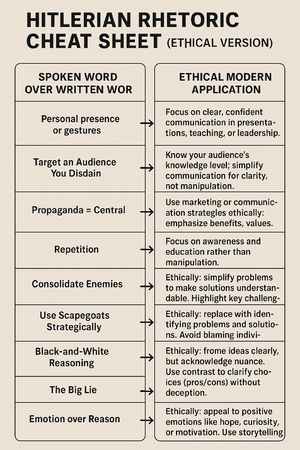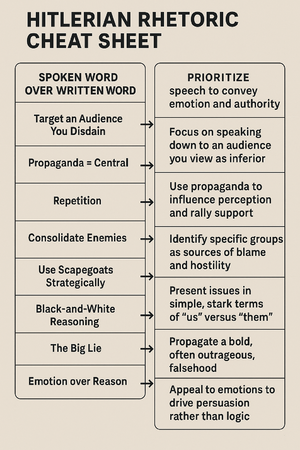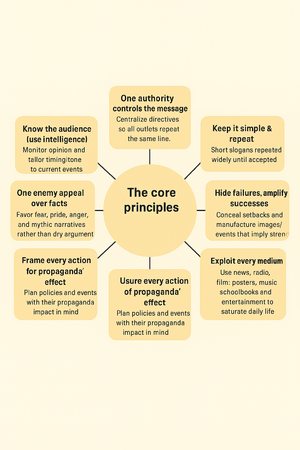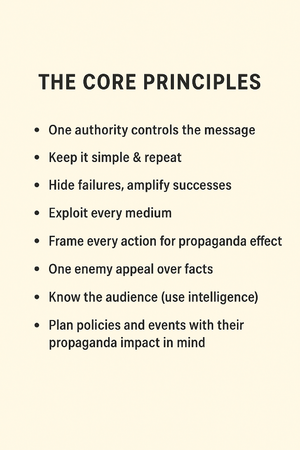- Joined
- Feb 24, 2024
- Messages
- 442
- Thread Author
- #1
Goebbels’ Propaganda Principles
Centerpiece (Title box in middle):
Joseph Goebbels’ Propaganda Principles
Nazi Minister of Propaganda (1933–1945)
Surrounding Nodes (circle around center):
- Central Control
One authority directs all messaging.
→ Unified tone across press, radio, film. - Audience Targeting
Monitor opinion → tailor to mood/events.
“Right message, right time.” - Simplicity & Repetition
Short slogans, repeat endlessly.
“Make it familiar = make it true.” - Emotional Appeal
Trigger fear, pride, anger, hope.
Facts secondary. - Single Enemy
Identify a scapegoat → blame for problems.
Creates unity + moral clarity. - Hide Weakness, Show Strength
Conceal failures, stage successes.
Image management over reality. - Total Media Saturation
Use all channels: news, art, film, radio, schools.
Propaganda in daily life. - Propaganda First
Plan actions with their propaganda effect in mind.
Policy becomes theater. - Repetition + Conformity Pressure
Repeat lines → silence dissent.
Social cost for disagreement. - Narrative Packaging
Bundle complex issues → simple, emotional stories.
Bottom Banner (Practical Spotting Tips):
- Same wording repeated everywhere.
- Complex issues reduced to 1 villain.
- Emotional slogans > factual arguments.
- Appears across news, entertainment, education.
Here’s how Hitler’s rhetorical theory worked:
1. Spoken Word Over Written Word
- Principle: Oral persuasion is more powerful than written persuasion.
- Application: Focus on speeches, rallies, and direct communication rather than essays or articles. Your tone, gestures, and presence are critical.
2. Target an Audience You Disdain
- Hitler assumed the masses were “slow,” “primitive,” and easily influenced.
- Implication: Simplify your message, repeat it often, and do not expect your audience to critically analyze complex ideas.
3. Propaganda is Central
- Principle: Mass persuasion and propaganda are inseparable from rhetoric.
- Tactics:
- Focus on a few key messages.
- Repeat them constantly (repetition reinforces memory).
- Use emotional appeal rather than logical reasoning.
4. Repetition
- Repeat slogans or ideas over and over until the audience “understands.”
- Example: Emphasizing a single narrative like “the enemy is [X]” until it becomes unquestioned.
5. Consolidate Enemies
- Limit your audience’s focus to one enemy or problem.
- Avoid multiple targets, as too many complicate the narrative and reduce persuasion.
6. Use Scapegoats Strategically
- Hitler identified Jews as the ultimate scapegoat for all societal problems.
- Conceptually: creating a clear “us vs. them” narrative heightens emotional engagement—but it is extremely dangerous.
7. Black-and-White Reasoning
- Present issues as all good or all bad, right or wrong. Avoid nuance.
- Simplifies the message and makes decision-making easy for the audience.
8. The Big Lie
- Large, audacious lies are more believable because people cannot imagine such bold falsehoods.
9. Emotion Over Reason
- Appeal primarily to feelings: fear, anger, pride, loyalty.
- Reasoning should be secondary, because the majority of people, Hitler believed, are swayed more by passion than intellect.
Summary of Hitlerian Rhetoric
- Speak directly and powerfully.
- Simplify ideas for an “unthinking” mass audience.
- Repeat the same message constantly.
- Focus on one enemy or problem.
- Use emotional, passionate appeals over logic.
- Use bold lies to create narratives the audience cannot doubt.
- Employ black-and-white reasoning.
CHAT-GPT WAS USED TO ORGANIZE THIS INFORMATION, FOR MORE INFO PLEASE VISIT THE FOLLOWING SITES TO VIEW THIS INFORMATION IN ITS TOTALITY.

Hitler and Rhetoric - Patricia Roberts-Miller
As Nicholas O’Shaughnessy says, anyone looking at the devastation of World War II and the Holocaust is likely to wonder: “How was it possible for a nation as sophisticated as Germany to regress in the way that it did, for Hitler and the Nazis to enlist an entire people, willingly or otherwise...
www.patriciarobertsmiller.com




